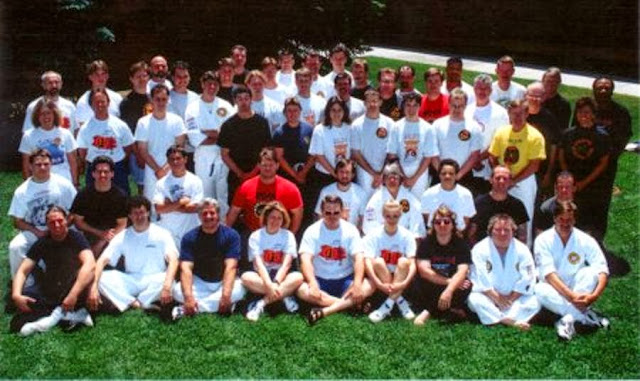Daniel San, “So, karate's fighting. You train to fight”
Miyagi, “That what you think?”
Daniel San, “No”
Miyagi, “Then why train?”
Daniel San, “So I won't have to fight?”
Just like Mr. Miyagi in the original Karate Kid movie, traditional martial arts have lineage to show credibility and legitimacy. This is how the Okinawan martial arts system has developed legitimacy over centuries - it is traditional and it is effective.
.jpg&container=blogger&gadget=a&rewriteMime=image%2F*) |
| "Bow to each other". Bowing in Okinawan martial arts known as 'rei', is very important to instill respect for all people who train in martial arts. |
One martial arts school in the East Valley of Phoenix really shines when it comes to Traditional Okinawa martial arts. The school referred to as the Arizona Hombu. For those who do not train in "traditional karate" or understand Japanese, a hombu is rare in the West as this is the headquarters for a specific system or style of martial arts. To have a Hombu dojo, it must be sanctioned by the grandmaster of the style. The grandmaster is the world head of the martial arts style (known as ryu) and teaches at a hombu.
There are two traditional and legitimate ways one can achieve the level of grandmaster. One is to study the system for decades learning all that can be learned from the style and then be selected by the grandmaster to inherit the style upon death. The other is similar. One must study a martial art system for decades and develop a hybrid that becomes recognized by a legitimate martial arts association and its grandmaster. In both cases, a grandmaster must have decades of experience and many unique qualities. He must be a world class instructor.
Unfortunately, some in the West have declared themselves to be grandmaster with no legitimate right. Such self-proclaimed illegitimate grandmasters can be likened to a person awarding himself with a PhD in astrophysics. Simply because a person read a book on astrology, does not make that person an astronomer.
Most people in Tempe and Scottsdale have a general idea of what karate is – a martial art created on Okinawa a few centuries ago, but only a small percentage of the population is familiar with kobudo. Kobudo and karate have always been blended in Okinawan martial arts schools, the place of birth of karate. In the 15th century, Okinawan King Shoshin was concerned about possible civil unrest and was also a non-violent Buddhist. Based on his concerns, he issued an edict banning all weapons on his island kingdom. However; his subjects were not convinced that a non-violent agenda would give them peace. Thus, the people of Okinawa developed kobudo, a martial art of tools used in self-protection. They began to train with tools of trade such as hoes, rakes, sticks, oars, fish hooks, etc. as weapons.
Professor Hausel celebrated his Golden Anniversary in martial arts in 2014. With so many years of training and teaching, this gives him an unique perspective of martial arts. While at the University of Wyoming, he was awarded title of Professor of Martial Arts by an international American-Japanese-Okinawan martial arts association and taught a variety of martial arts for three decades at the university in addition to his geological research. Over three decades, a few thousand students and faculty trained in traditional martial arts and many were awarded yudansha (black belt) at various levels. Soke Hausel retired from the university in 2007 and taught classes for a short period at Arizona State University before opening a public school for his hombu in the East Valley of Phoenix.
| Dr. Florence Teule from France using back fist at the Arizona Hombu. |
The type of martial arts taught at the Arizona School of Traditional Karate have become known as the Tim the Tool Man Taylor More Power martial arts. Using hip rotation, perfect balance and accelerating forward, or grabbing an attacker and accelerating them into a punch or kick, or just stepping aside, his students are learning to develop as much power per punch as can be obtained. Students also learn to use many different weapons, which is very important in Okinawa Karate. At one clinic, Soke taught his students to use a kuboton which he sometimes substitutes short sticks, pens, pencils, memory sticks, magazines and even Duck Commander duck calls in classes and clinics.
Self-defense clinics at the Arizona Hombu have also been popular.
Students at the Arizona Hombu include doctors, lawyers, engineers, teachers, professors, scientists, law enforcement agents, etc. The doors to the Hombu are open to any non-violent and humble individuals interested in learning Okinawan martial arts from a Hall of Fame martial artist.
| Two yudansha (black belts) at the Arizona Hombu |
| Soke Hausel (center) at the University of Wyoming where he taught a martial arts clinic for the 30th anniversary of the University of Wyoming Campus Shorin-Ryu Karate and Kobudo Club |
Dr. Neal Adam (far right) from Grand Canyon University trains with Dr. Jesse Bergkamp from Arizona State
University at the Arizona School of Traditional Karate (Arizona Hombu).
|
